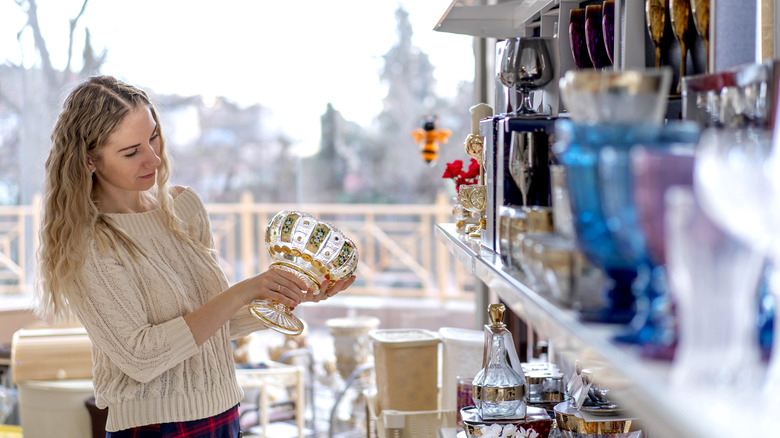The Valuable Marking You Should Always Look Out For When Thrifting For Glassware
Whether you're looking to save money, while away a slow weekend morning, or dress up your home with creative finds, thrifting is the way to do it. You might come home with new mugs, a gorgeous photo frame, vintage wood furniture, or a stack of vinyl to spin on your recently acquired record player. But there's something else that makes thrifting a real win: the chance to uncover something rare. While we're used to seeing signatures on paintings, there's a valuable marking to look out for on glassware. And that's the signature of René Lalique — a renowned French glassmaker celebrated for his Art Nouveau and Art Deco designs.
Lalique began producing glass in the early 1900s, and his work quickly became known for its elegance, fine craftsmanship, and collector appeal. Pieces made by René himself, before his death in 1945, are especially sought-after. If you happen to spot the right marking, your next thrifted vase or bowl could be worth hundreds or even thousands.
How to tell if your thrifted glassware is genuine Lalique
So, how do you know if that piece of thrifted glassware is your next DIY project or a Lalique original? The first thing to check is the signature. Genuine Lalique glass is always marked, but the exact signature varies depending on when the piece was made. Works crafted during René Lalique's lifetime (1905–1945) typically read "R. Lalique" and are considered the most valuable. After his death, the company dropped the "R," and by 1978, newer pieces often included a circled "R" trademark — signaling a more modern production.
Authentic Lalique pieces are usually engraved or etched in an unobtrusive spot, like the underside. In contrast, fakes often feature bold, obvious cursive signatures that are too large or oddly placed. Other clues include weight (genuine Lalique is heavier due to its lead content), clarity (high-quality crystal is clearer than cheaper imitations), and design precision. Common motifs include birds, flowers, fish, and elegant female figures — all rendered with remarkable detail. And while Lalique glass comes in just a few colors — clear, amber, green, red, and blue — red is the rarest and most likely to be fake. If something feels off, it probably is, but if all the signs add up, you just might have a hidden gem in your hands.
What to do if you spot that valuable marking on glassware
If you've spotted an "R. Lalique" signature etched into the base of a beautiful vase, what now? Have you really just thrifted your way into a small fortune? Before you start mentally spending your newfound wealth, you first need to make sure it's the real thing. Start by researching the piece. A quick image search using model names like "Perruches vase" or "Longchamps car mascot" can help confirm its authenticity, especially since Lalique produced many pieces in large numbers. If the signature matches the right era and the design checks out, you may be looking at a valuable find. Of course, you will need to verify that with a bona fide appraisal expert.
Vintage shops, antique fairs, and estate auctions are great for buying art. However, for selling — especially if you're dealing with something as valuable as pre-1945 R. Lalique glass — it's best to have a reputable dealer work on your behalf. Look into auction houses like Dawsons or Christie's, which attract serious buyers and can provide expert valuations. Authentic Lalique glass can range from a few hundred dollars to tens of thousands, depending on condition, rarity, and color. So if that marking checks out, take a breath — you may have uncovered something truly special.

